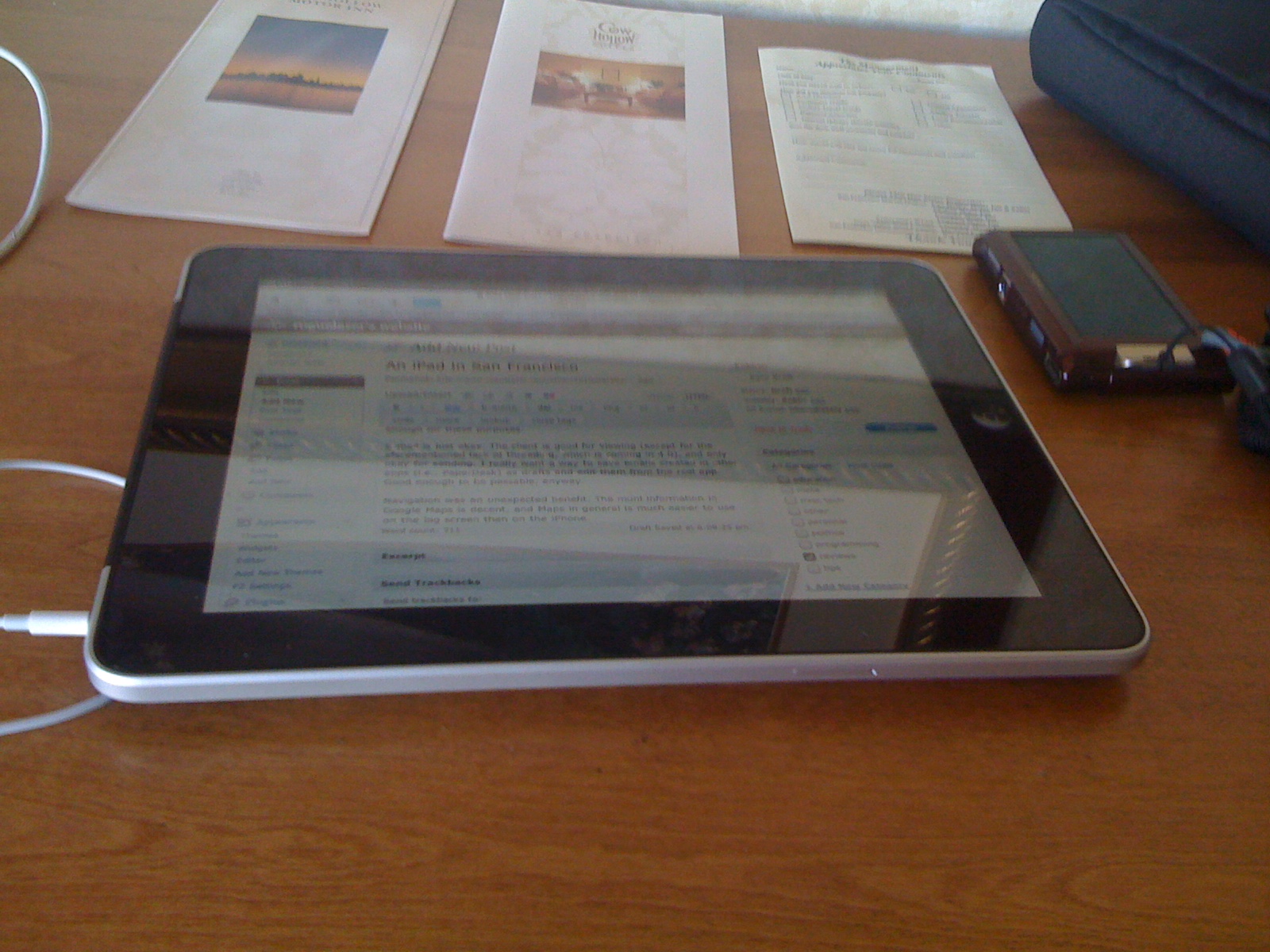An iPad in San Francisco

So, I've been in San Francisco apartment-hunting for the past couple of days (I found a place!), and the only computers I brought with me are my iPad and my iPhone. It occurred to me that this might be a useful basis for a review, so enjoy. As a reminder, I have the 64GB model with 3G and WiFi.
In brief, I am extremely satisfied. I have been using the iPad to browse Craigslist, listen to music, keep up with my e-mail (including a community-l thread that made me long for the upcoming threaded mail view), and so on. It has excelled at all of these tasks, and done so with battery performance that continues to amaze me.
Web browsing is, of course, the iPad's forte. I've tried both craigsphone and CraigsFish for the iPad, and they are both inferior experiences to just using craigslist in the browser. That is because it is awesome in the browser. Speedy to load (a big plus on AT&T in SF), and easy to interact with via touch. It occurs to me that I could have used Prowl to push phone numbers to my iPhone, but I didn't think of that at the time. I really need bidirectional clipboard sharing between iDevices...
Music and other media consumption is also a pleasure on the iPad. Simply having 64G of space means that I can take all of my AAC music (lots is still in FLAC only, but whatever), some TV, and still have lots of space left. Sound quality isn't great, but it is good enough for these purposes. I had crappy headphones all week anyhow.
E-mail is just okay. The client is good for viewing (except for the aforementioned lack of threading, which is coming in 4.0), and only okay for sending. I really want a way to save emails created in other apps (i.e., PaperDesk) as drafts and edit them from the real app. Good enough to be passable, but plenty of room for improvement.
Navigation was an unexpected benefit. The muni information in Google Maps is decent, and Maps in general is much easier to use on the big screen than on the iPhone. No iBART for iPad yet, but BART is simple enough to not really need it.
Blogging is problematic. I've composed most of this post on the iPad (in my hotel room, actually), but can't post it as I want it from here because I can't add any pictures. The web interface has no way to upload from the iPad's photo library, and the native client is super-crashy. I guess I'll have to add the pictures from another computer, later.
However, actually entering text is pretty great. I've gotten quite fast at typing on the landscape keyboard with the iPad on my lap or a table. I can thumb-type pretty well in portrait mode, and am working to get better. Some of the auto corrects are weird, though. It corrects "ive" to "vie" instead of "I've" unless it's the first word in a sentence, and that seems like a much less likely correction. It also misses some fat-fingers that it should be able to get by key proximity (for example, "grt" instead of "get"). However, it's definitely good enough to write a few hundred words on.
What else...? 3G is awesome. I have had dropped calls on my iPhone in SF, but have had great data access everywhere on my iPad. It's only about 600k/s, but fast enough for craigslist and IM. Oh, also, the official AIM app has been super nice. There's really nothing like being able to IM with a good friend while waiting for a real estate agent who is running late for a showing. I know that Beejive and IM+ are supposedly quite good, but I kind of like the official AIM app more. shrug.
San Francisco has been quite a nice city to use it in. I have felt safe using it pretty much everywhere I have been, including on the bus. And people ask about it pretty much everywhere. I think I convinced a woman in the Starbucks on Powell and Sutter to get one. I don't count myself as much of an Apple Fanboy (I like their products objectively, dammit), but I think I did some good iPad evangelization.
So, that's my review. As you might have expected, I'm pretty happy with it. Feel free to leave comments (or tweet @Roguelazer) with questions or thoughts.



